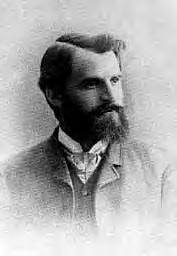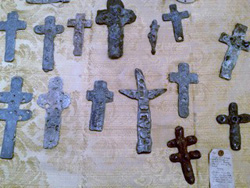The Mystery of the Buried Crosses
Posted on 27 August 2013, 11:38
When asked not long ago to name what I thought to be the most intriguing book in the annals of psychical research, I narrowed it down to three stories: Psychic Adventures in New York, The Case of Patience Worth, and The Mystery of the Buried Crosses, not necessarily in that order. The first book was discussed in this blog in my April 22 post, while the Patience Worth story was posted on June 17. Therefore, it’s time to discuss the buried crosses.
In his 1939 book, The Mystery of the Buried Crosses, Pulitzer Prize winning author Hamlin Garland (1860-1940),told of some 1,500 buried crosses and other Indian artifacts dug up at various sites in Southern California and Mexico by Gregory and Violet Parent at the direction of spirits through the mediumship of Violet Parent. After their deaths the artifacts were given to Garland by a relative of the Parents.
In addition to the artifacts, Garland was given 22 notebooks belonging to the Parents. They indicated that there were more artifacts to be found. Garland set out to find them and solicited the help of Sophia Williams, (below) a direct-voice medium from Chicago. Unlike most direct-voice mediums, however, Williams did not require darkness and did not go into a trance.
She would place the larger end of a megaphone against her breast while Garland would listen for voices at the smaller end and relay them to a stenographer. In his very first “sitting” with Williams, Garland was greeted by one of his oldest friends, Henry B. Fuller, who had helped him research cases of mediumship when he was alive. Always on the lookout for fraud, Garland wondered if Williams had read of Fuller in his 1936 book, Forty Years of Psychic Research. A few minutes later, another voice was heard. The spirit identified himself as Lorado, his wife’s brother, who had died the prior year.

Garland noted that Fuller called him by his last name, while Lorado addressed him by his first name, exactly as they had done when they were alive. He further noted that the voices, which were high in vibration, sometimes seemed to be coming from the megaphone and at other times from the air above the medium’s head.
The most convincing evidence came when a voice addressed Garland’s stenographer, Gaylord Beaman. “Gay, this is Harry,” the voice was heard. When asked for a last name, “Friedlander” was given. The astonished Beaman explained to Garland that Harry Friedlander was a friend who died in a plane crash in San Francisco Bay. The spirit then gave some details concerning the crash. Garland was certain that Williams knew nothing of Beaman and could not have researched this information beforehand.
Two days later, the second sitting took place. Garland first heard a voice say, “This is Turck, Dr. Turck.” Turck went on to tell Garland that he (Turck) was an “old fool” for having called Garland’s psychical research so much “humbuggery” when he was alive. Here again, Garland concluded that the medium could have known nothing about Turck’s attitude, which had been expressed at a luncheon.
When the voice changed, Garland asked the speaker to identify himself. “Doyle,” the voice replied. It was Sir Arthur Conan Doyle, the creator of Sherlock Holmes, another psychical researcher known to Garland when he was alive. Doyle said that Sir William Crookes and Dr. Gustave Geley, two more famous psychical researchers who had died, were there with him. They all spoke and said they were there to help Garland communicate with their side of the veil. Geley began speaking in French until Garland told him that he was not fluent in French. Geley then switched to English. Professor William James also spoke, but Garland was unable to understand what James was saying.
More spirits came, including one who identified himself as Harry Carr, another of Beaman’s friends. Carr asked Beaman to contact his friend Lee Shippey to see if his manuscript might now be published. Here again, this was highly evidential as the names and information were well beyond the scope of research.
Garland’s old friend, Burton Babcock, then communicated. Garland described Babcock’s speech as “hesitating and incoherent,” which was characteristic of him when he was alive. Rudyard Kipling broke in at one point, speaking Gaelic before switching to English with an Irish brogue. William Stead also came through and confirmed that the photo in Mrs. Parents’ album was genuine, commenting that he used to wear the cloak that Garland thought looked “absurd.”
Indeed, it appeared that a whole group of people, including some very famous ones, had gathered on the other side to avail themselves of Williams’s mediumship. Some spirits unrelated to Garland’s search spoke at times. One identified herself as Leila McKee, an old Wisconsin acquaintance. Another Wisconsin acquaintance, Wendell McIldowney, also came through. While Garland had by this time concluded that Williams was not a charlatan, he knew he had to be ready for claims by skeptics that Williams had done some research before meeting him. It would have been virtually impossible, he concluded, for any researcher to turn up either of these names from his past.
Still, Garland wondered if Williams was somehow unknowingly tapping into his subconscious. However, his subconscious could not possibly be involved in directing Williams to uncover additional crosses or other artifacts. If the spirits could help him uncover more artifacts, that would, Garland reasoned, be solid proof of the existence of a spirit world and, concomitantly, life after death.
Conan Doyle brought George Parker Winship, an ethnologist when he was alive, to comment on the crosses. Winship explained that some of them were from Central America – from Yucatan and Guatemala – and preceded Christianity. It was further explained that the Indians brought them from those countries during the 16th Century when the invading Spaniards forced them to move to California
When a voice clearly announced, “This is Father (Junipero) Serra,” Garland was astounded and wondered if his mind were playing tricks on him. He was also surprised that Serra spoke English, as one reference indicated he did not. Serra told him that the book was wrong and that there was only one language on his side. He further told Garland that the crosses were of pagan origin and that the Indians buried them in ceremonies to appease their gods. He added that he prohibited such pagan worship but was unable to control the wild Indians.
At the direction of Serra and other “Invisibles” who spoke through the medium’s megaphone, Garland and Williams traveled hundreds of miles through southern and central California and Mexico searching for more artifacts. They were often accompanied by relatives or friends to help them in the search and in the digging. The spirits would tell them where to go, where to stop, which direction to walk, and then where to dig. They found 16 artifacts, similar in substance and design to those collected by the Parents, in 10 widely separated locations.
Some were in deep gullies, others high on cactus-covered hills far from the highway. One was hidden in a ledge of sandstone behind a wall of cactus plants which Garland had to chop away before finding it. For the skeptic who might have claimed that Williams went all over the state planting the artifacts for Garland to find, Garland wrote that this would have been an impossible task. Moreover, it was clear that the grounds covering the artifacts, some buried more than two-feet deep, had not been disturbed for many years. It was equally clear that Williams had neither the time nor the motive to carry out such a hoax.
Garland (below) had ended his 1936 book still a little skeptical when it came to psychic phenomena, although his skepticism had to do more with whether it was proof of life after death rather than whether it was supernatural. Although he could not bring himself to state it in so many words, he appears to have finished his 1939 book on the buried crosses as a believer in life after death. How many readers of his book were convinced is unknown. The story probably exceeded the “boggle threshold” of the average reader and was looked upon as nothing more than a work of science fiction.

As for the crosses and other artifacts, 12 of the 16 found by Garland are now on display at the West Salem Historical Society Museum in Wisconsin. It is unknown what happened to the other four. The original 1,500 or so were apparently donated by Garland to the Museum of the American West in Los Angeles in 1939, but they are no longer in the museum’s inventory and nobody seems to know what happened to them.

A few years ago, Lisette Coly, the granddaughter of renowned trance medium Eileen Garrett (1893-1970) and executive director of the Parapsychology Foundation, discovered 27 of the original 1,500 in a box in her basement, having been sent to her grandmother in 1966 by the son of the publisher of Garland’s book. The box was marked “Hamlin Garland.” The whereabouts of the other 1400-plus artifacts is unknown. Perhaps, they, too, are stored in a basement somewhere and will turn up at a garage sale or flea market.
There is so much more to this story. For those interested in reading it, Garland’s book The Mystery of the Buried Crosses has recently been republished by White Crow Books
Michael Tymn is the author of The Afterlife Revealed: What Happens After We Die is published by White Crow Books. His latest book, Resurrecting Leonora Piper: How Science Discovered the Afterlife is now available on Amazon and other online book stores.
Paperback Kindle
Next blog post: Sept. 23.
Read comments or post one of your own
|